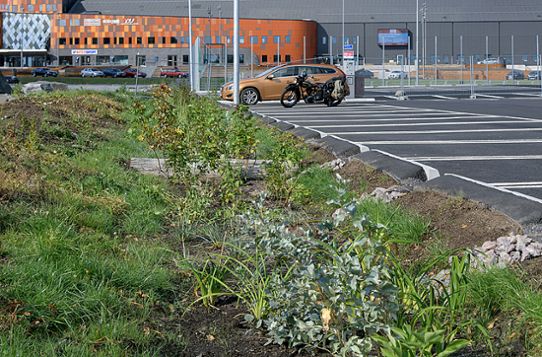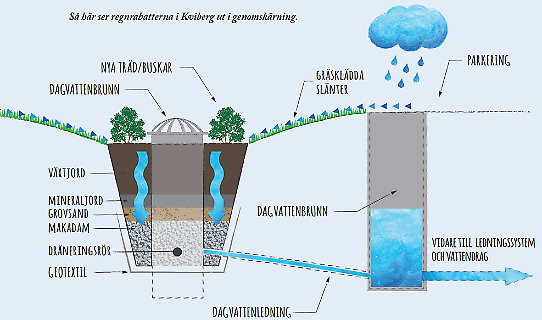As climate change progresses, levels of precipitation are increasing, sea levels are rising and extreme weather conditions are becoming more common. The risk of flooding is therefore becoming more palpable, which is creating a need for effective solutions to the management of surface runoff.
Kviberg multi-sport arena was completed in summer 2015 in north-eastern Gothenburg. The facility is surrounded by parking for 500 cars. In order to deal with the rainwater that runs off the parking surface, around five per cent of the total surface area has been given over to rain borders, which both purify and retard the surface runoff.

Purifying the surface runoff is especially important at Kviberg multi-sport arena as it is close to the river Säveån, a Natura 2000 area. The City of Gothenburg also has an explicit environmental objective pertaining to natural surface runoff purification that the city has to work towards achieving. Consequently, a partnership between the municipal departments Sustainable Waste and Water and Parks and Nature. The City of Gothenburg’s parking company has also shown interest and financed the construction of these rain borders.
Why rain borders?
The City of Gothenburg has found inspiration for the rain borders as a solution for the management of surface runoff in completed projects in other cities. Rain borders are also known as biofilters, rain beds or rain gardens. They constitute a smart, cost-effective solution that has several functions, which also means that resources do not have to be devoted to several different measures. By employing several layers of special soil, the surface water that runs off hard surfaces is filtered and purified. The borders do not simply retard the flow of large quantities of surface water in the event of torrential rain, the specially composed growing beds also mean that the soil retains moisture better, which is particularly important for plants during long dry periods. In addition, facilities with plenty of greenery in an urban environment can reduce noise, improve the local climate and air quality. Rain borders therefore contribute to important ecosystem services. People also feel better when they are close to nature, at the same time as insects and other organisms are given the opportunity to thrive.

The design and location of rain borders varies depending on the construction conditions, level of pollution and any specific requirements. At the very least, all rain borders have the following constituent parts: Inflow, retardation zone, erosion protection, various layers of soil, overflow drain and some form of dewatering system. The borders in Kviberg are also designed in this way, at the same time as problems and local conditions at the site in question have been taken into consideration.
The plants in Kviberg’s rain borders vary from grass to trees. The types of plant used have to be able to cope with the living conditions in the border. At times there can be a lot of water, at other times it can be very dry.
Costs
The cost of the entire project is estimated at approximately SEK 2.6 million. The cost of building rain borders varies depending on size, equipment and ground conditions. In the case of Kviberg, the cost is estimated as about SEK 2 500–3 000 per square metre, including materials, drainage and labour costs during construction. With regard to the costs of maintenance, these will not be much higher than the cost for normal growing beds as the procedures are about the same.
More examples of climate adaptation
This is one of many examples of climate adaptation. There are more in the collection of ideas being built up by the Swedish National Knowledge Centre for Climate Change Adaptation at the Swedish Meteorological and Hydrological Institute (SMHI). The collection of examples has the aim of sharing experiences and providing ideas to everyone who works with climate adaptation. Examples describe concrete measures and challenges in several subject areas. They show how different actors have worked to adapt their activities to the climate changes that are already being noticed today and those that we cannot prevent in the future.